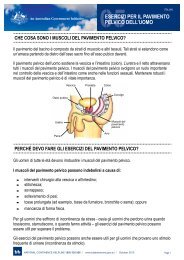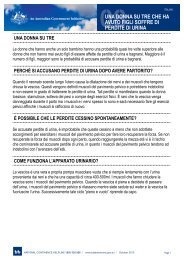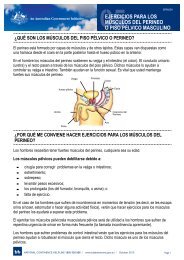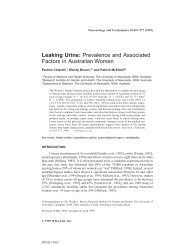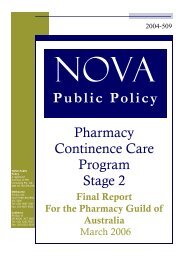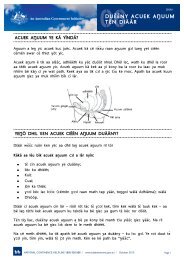Continence Tools for Residential Aged Care - Bladder and Bowel ...
Continence Tools for Residential Aged Care - Bladder and Bowel ...
Continence Tools for Residential Aged Care - Bladder and Bowel ...
Create successful ePaper yourself
Turn your PDF publications into a flip-book with our unique Google optimized e-Paper software.
Frequently asked questions about completing the Three Day <strong>Bladder</strong> Chart<br />
When should the Three<br />
Day <strong>Bladder</strong> Chart be<br />
commenced?<br />
Why maintain the Chart<br />
<strong>for</strong> three days?<br />
How frequently should<br />
residents’ urinary<br />
continence status be<br />
checked?<br />
How is in<strong>for</strong>mation<br />
collected to complete<br />
the Three Day <strong>Bladder</strong><br />
Chart?<br />
What should be done<br />
with the in<strong>for</strong>mation<br />
from the Three Day<br />
<strong>Bladder</strong> Chart?<br />
The best time to commence the Three Day <strong>Bladder</strong> Chart is when the<br />
resident is settled <strong>and</strong> familiar with their surroundings. This timing varies<br />
from resident to resident but usually it can be commenced one to two<br />
weeks after the resident is admitted to the facility. Other times that the<br />
Three Day <strong>Bladder</strong> Chart may be appropriate to use are when you are<br />
reviewing the resident’s continence status <strong>and</strong> when you wish to monitor<br />
the effectiveness of care.<br />
The Three Day <strong>Bladder</strong> Chart should be maintained <strong>for</strong> a minimum period<br />
of 3 complete <strong>and</strong> consecutive 24-hour periods (including day <strong>and</strong> night).<br />
If it is not possible to monitor the resident’s bladder elimination over 3<br />
consecutive days, the chart can be completed over 3 separate, complete<br />
24-hour periods. Three days is the average time that it takes to identify<br />
residents’ bladder patterns. Some residents may need a longer period<br />
of monitoring.<br />
It is preferable to monitor the frequency of the resident’s bladder elimination<br />
<strong>and</strong> urinary continence status closely during the assessment period. More<br />
frequent observations provide more accurate in<strong>for</strong>mation on which to base<br />
a care plan. The frequency of checks <strong>and</strong> the manner in which they are<br />
conducted should not interfere with the resident’s usual activities.<br />
Ideally, in<strong>for</strong>mation to complete the Three Day <strong>Bladder</strong> Chart should be<br />
provided by resident’s themselves, however, due to dementia <strong>and</strong> other<br />
health related conditions, this is often not possible. Identify if the resident<br />
is continent or not during the designated time periods. Discreetly observe<br />
<strong>for</strong> urine loss when providing personal care (i.e. during toileting or hygiene<br />
assistance). If the resident is using a pad, check <strong>for</strong> a wetness indicator<br />
(usually located on outside of pad). Also observe <strong>and</strong> document how many<br />
drinks the resident has within the designated time periods; what type <strong>and</strong><br />
what amount.<br />
In<strong>for</strong>mation from the Three Day <strong>Bladder</strong> Chart should be used to complete<br />
the <strong>Continence</strong> Assessment Form <strong>and</strong> <strong>Care</strong> Plan (Sections B & C). Another<br />
use of the in<strong>for</strong>mation from the Three Day <strong>Bladder</strong> Chart is to assist you<br />
to complete sections 4 & 5 of the ACFI (Toileting <strong>and</strong> <strong>Continence</strong>). Review<br />
the in<strong>for</strong>mation collected over a 3 day period to decide whether or not a<br />
resident has a predictable pattern of voiding. If yes, develop <strong>and</strong> put in<br />
place an individualised toileting program that is based on this pattern.<br />
If no, develop <strong>and</strong> put in place a fixed time toileting program (such as every<br />
3 or 4 hours during the day).<br />
7



